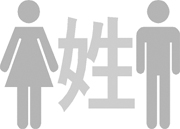What’s in a name?

There were merely around 500 family names in China in its first recorded compilation of top surnames before 400 B.C. With its vast population of 1.3 billion, there are now considerably more Chinese family names. However, it is still relatively small compared to Japan, where there are believed to be approximately 300,000 different surnames.
The family name is paternal, inherited from the father. For the past three millenniums, Jewish priests have used the surname “Cohen” derived from the Hebrew word kohen for “priest.” Permanent surnames began to be widely used around the 12th century, when occupations or birth origins became inadequate indicators of someone’s name or social standing.
In China, the use of surnames began around 2,000 years ago. Confucius, who was honored at the opening ceremony of the Beijing Games, was as much a great teacher as he was a father.
It is estimated that there are more than three million descendants of Confucius in the world, including 2.5 million on Chinese soil. The latest version of his family tree will be published in 2009, according to the Confucius Genealogy Compilation Committee. The number in the updated tree now stands at more than 1.8 million. Some descendants with no data to back up their genealogy claims had hoped to submit DNA samples but were rejected by the committee.
From a biological perspective, the Y chromosome contains the gene that triggers male embryonic development. Just as surnames are inherited from generation to generation, the sex-determining Y chromosome, serves as a genetic bridge between father and son. Males have one Y chromosome and one X chromosome, while females have two X chromosomes. The Y chromosome comprises just one-tenth of genes that determine protein production compared to the X chromosome. Males predominantly have genes that cause color-blindness, autism and hemophilia, traits located in the X-chromosome.
Some scientists insist that as the quality of the Y chromosome is degraded, it will disappear in 120,000 years.
Who knows. Perhaps a new era - with no distinctions between family names and sex - will come, driven by social changes and biological evolution.
The writer is a JoongAng Ilbo reporter who specializes in environmental issues.
By Kang Chan-soo [virepo@joongang.co.kr]










with the Korea JoongAng Daily
To write comments, please log in to one of the accounts.
Standards Board Policy (0/250자)